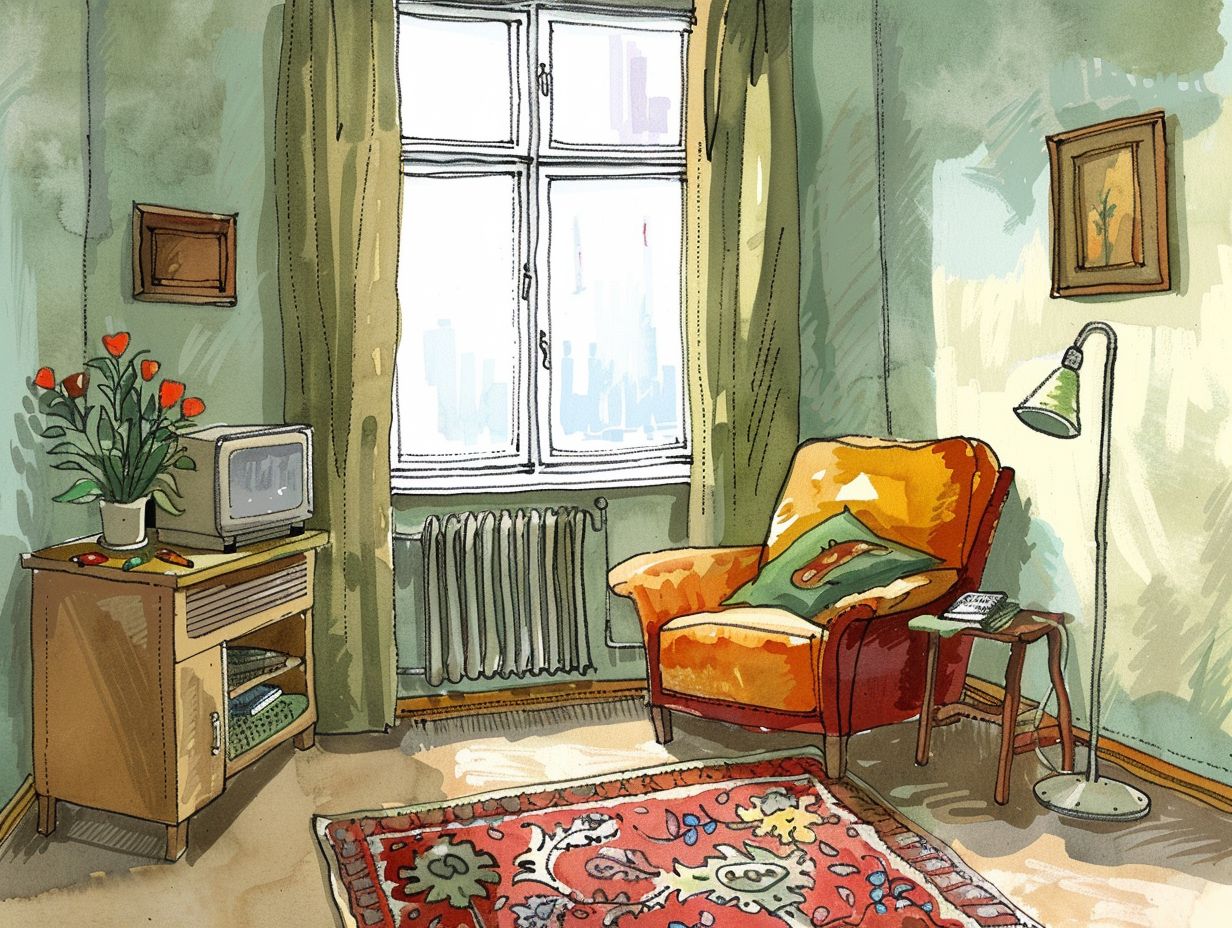Are you looking to create a warm and cosy atmosphere in your living room during the colder months? Living room radiators are a popular choice for efficiently heating up your space. This article explores the different types of living room radiators available, including electric and central heating options.
It also discusses key factors to consider when choosing the perfect radiator for your home, as well as advice on installation and upkeep. Discover eco-friendly options that allow you to reduce your carbon footprint.
Key Takeaways:

- A living room radiator is a heating device that helps regulate the temperature in a room, specifically the living room.
- There are two main types of living room radiators: electric and central heating. Each has its own benefits and considerations.
- When choosing a living room radiator, factors such as size, heat output, style, and maintenance should be taken into account to ensure optimal performance and efficiency.
What is a Radiator?
A radiator is an essential component in any household, particularly in areas like the living room, where it serves as a primary source of heating during colder seasons. Radiators are available in a variety of styles and designs, catering to both traditional and modern preferences, all while effectively heating the living space.
Radiators play a pivotal role in creating a comfortable living environment by efficiently circulating heat, ensuring that occupants remain warm and cosy even in freezing temperatures. Along with their functional aspect, radiators have evolved into stylish interior features that can enhance the overall ambiance of a room.
With a diverse range of styles available, from sleek and minimalist to ornate and vintage-inspired designs, radiators not only serve a practical purpose but also serve as aesthetically pleasing additions that complement various interior aesthetics in any home.
Types of Living Room Radiators
When considering living room radiators, you can explore a range of options that seamlessly combine functionality and style. For instance, the Milano Windsor column radiator offers an elegant addition to your space.
These radiators are versatile and can be installed either vertically or horizontally. In addition, some models are designed as electric radiators, merging contemporary luxury with effective heating solutions.
Electric Radiators
Electric radiators serve as a contemporary heating solution that offers both style and functionality to your living room. These radiators, featuring sleek panel designs, are ideal for creating a cosy boho atmosphere while effectively warming the space.
Their modern appeal stems from their ability to seamlessly work together with various interior styles, ranging from minimalist to eclectic. The sleek panel design not only elevates the room’s aesthetic but also ensures efficient heat distribution.
Electric radiators often include programmable features that enable you to tailor heating schedules for optimal comfort. The inviting boho ambiance they radiate makes them a sought-after option for individuals who prioritise warmth without sacrificing style.
Central Heating Radiators
Central heating radiators are an excellent choice for a modern living room, seamlessly blending with the decor while preserving the original character of the space. Options such as low-level radiators provide a combination of functionality and style, elevating the overall ambiance of the room.
The appeal of central heating radiators lies in their capacity to evenly distribute heat throughout the room, creating a comfortable environment for all occupants.
These radiators are available in various designs, allowing homeowners to select a style that complements their existing decor.
Low-level radiators, specifically, emit heat at ground level, making them well-suited for spaces with large windows or high ceilings. This not only aids in maintaining a consistent temperature but also adds a touch of sophistication to the room.
Factors to Consider when Choosing a Living Room Radiator

When selecting the right living room radiator, you should carefully consider factors such as size, heat output, style, and design. This will ensure that the radiator not only complements the space’s cosy ambience but also adds character to the room.
Size and Heat Output
When considering the size and heat output of a living room radiator, you must ensure it is adequate to maintain a warm and comfortable environment, providing optimal heating for the space. The proper size and heat output of the radiator are critical factors in upholding a consistent and pleasant temperature within the room.
A correctly sized radiator will effectively distribute heat, preventing cold spots and ensuring even warmth throughout the area. The heat output should be chosen based on the room’s dimensions and insulation to avoid overheating or inadequate warmth.
By selecting a radiator that aligns with the room’s specific requirements, you can establish a welcoming and cosy atmosphere, ideal for unwinding and enjoying pleasant moments with your loved ones.
Style and Design
The style and design of a living room radiator play a critical role in enhancing the aesthetics of the room. Selecting a visually appealing radiator that complements the overall decor is essential not only for keeping the room warm but also for adding an element of sophistication to the area.
Elements of radiator design such as colour, finish, and material can have a significant impact on the ambiance of a room. For example, sleek, modern radiators with a metallic finish can create a contemporary atmosphere, whereas ornate radiators with intricate details can exude a sense of luxury.
Additionally, the size and shape of the radiator are important considerations; a vertical radiator may be well-suited for a narrow space, while a horizontal design can serve as a focal point in a room with lower ceilings. By thoughtfully choosing a radiator that complements the style of the room, you can enhance the overall look and feel of the space.
Installation and Maintenance of Living Room Radiators
Effective installation and correct maintenance are essential for ensuring the optimal performance of your living room radiators. As a homeowner, you may encounter the decision between DIY installation and professional services. Additionally, following regular maintenance tips can assist in extending the lifespan and efficiency of your radiators.
DIY vs Professional Installation
When deciding between DIY and professional installation for a living room radiator, you must take into account various factors, such as available space and the complexity of the installation.
It is crucial to have a clear understanding of the guidelines associated with each option to ensure a successful setup.
If you are considering DIY installation, you should feel confident in your plumbing skills and ability to follow detailed instructions. While DIY projects are typically more cost-effective and can offer a sense of accomplishment, it is important to assess your own skills and comfort level.
On the other hand, professional installation provides the expertise and assurance of a job well done, minimising the risk of errors. The amount of available wall space in the living room is a key factor in this decision, as certain radiator models may have specific positioning and clearance requirements.
Carefully measuring the space and considering the aesthetics of the room are essential when weighing the pros and cons of DIY versus professional installation.
Maintenance Tips for Optimal Performance

To keep your living room radiators running efficiently and extend their lifespan, it is crucial to implement regular maintenance practices. These tips are not only necessary for optimal performance but also contribute to an eco-friendly approach to home heating while preserving the radiator’s aesthetic appeal.
Ensure efficiency and prevent energy wastage by regularly inspecting and cleaning the radiator fins and vents to avoid dust build-up that can hinder heat distribution. Improve heat circulation throughout the room by bleeding the radiator to release trapped air pockets.
Choose non-toxic cleaning solutions and eco-friendly radiator paint to protect the environment and maintain the visual appeal of your living space. Consistent maintenance is key to enhancing the efficiency of your radiator, prolonging its durability, and ensuring it remains a sustainable heating solution for years to come.
Eco-Friendly Options for Living Room Radiators
Choosing eco-friendly options for your living room radiators involves selecting energy-efficient models and integrating renewable energy sources to keep a warm environment while reducing your environmental footprint. These choices not only guarantee efficient heating but also endorse a sustainable approach to home heating.
Energy-Efficient Models
Energy-efficient models of living room radiators combine contemporary design with functional style, offering effective heating solutions that are both environmentally friendly and visually appealing. These radiators are ideal for homeowners looking to reduce energy consumption while maintaining a stylish interior.
Their innovative technology ensures optimal heat distribution, creating a cosy and comfortable living space. Energy-efficient radiators can lead to substantial cost savings on heating bills over time, making them a practical choice for eco-conscious individuals.
With sleek and modern aesthetics, these radiators seamlessly blend into various home decor styles, enhancing the overall ambience of the room. Embracing these sustainable heating solutions not only benefits the environment but also adds a touch of sophistication to your home.
Renewable Energy Sources
Using renewable energy sources to power your living room radiators can help you create a stylish and eco-conscious home environment. This sustainable approach not only contributes to a cosy space but also enhances the overall decor with a focus on environmental responsibility.
Incorporating renewable energy sources like solar or geothermal power for heating can help you reduce your carbon footprint and lower energy bills. The use of renewable energy promotes a sense of modernity and eco-friendliness in your living room, making it a cosy retreat that is both aesthetically pleasing and environmentally sustainable.
Utilising eco-friendly heating options aligns with the growing trend of sustainable living, blending functionality with style for a harmonious home design.
Frequently Asked Questions
What Is a Living Room Radiator?

A living room radiator is a heating device that is specifically designed to provide warmth in a living room. It is usually installed on or near a wall and connected to a central heating system in a home.
How does a living room radiator work?
A living room radiator works by transferring heat from a central heating system into the room. Water or steam is heated through a boiler, and the hot water or steam is then circulated through the radiator, warming the air in the room.
What are the different types of living room radiators?
There are several types of living room radiators, including panel radiators, column radiators, and towel radiators. Panel radiators are the most common and are flat and slim in design. Column radiators have a more traditional look with multiple columns, and towel radiators are designed specifically for drying towels.
What are the benefits of using a living room radiator?
Using a living room radiator can help to efficiently and effectively heat a living room, making it a comfortable and cozy space. It can also add a decorative element to the room and can help to reduce energy costs by allowing for zoned heating in a home.
How do I choose the right size living room radiator?
To choose the right size living room radiator, you should consider the size of the room, the insulation of the room, and the heat output of the radiator. A general rule of thumb is to have a radiator with a heat output of 100 watts per square meter of living room space.
Can a living room radiator be used as the main source of heating in a home?
Yes, a living room radiator can be used as the main source of heating in a home. However, it is recommended to have additional heating sources, such as radiators in other rooms or a central heating system, for more evenly distributed warmth throughout the home.

